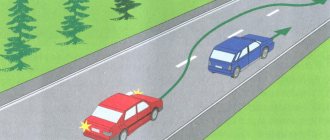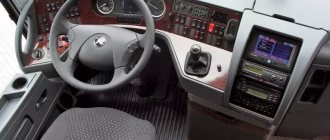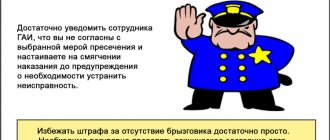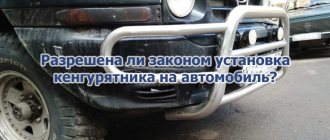What are noise stripes
Since this phenomenon on the roads is new to the Russian driver, you need to familiarize yourself with it in more detail. Noise strips are positioned as a cheaper alternative to speed bumps, the price of which is close to 200,000 rubles. This is quite a significant amount, especially for large cities with developed road infrastructure. The noise strip performs the same functions as a speed bump , but it is an order of magnitude cheaper.
What is the purpose
The function of the noise strip is simple - to force the driver to reduce speed and sharpen attention on a certain section of the road. This is achieved by applying stripes to the surface with a changed height relative to the road surface. As a result, the tires make a sound when they hit the markings, which the driver immediately pays attention to. The advantage of this invention is that, unlike the already familiar “speed bump”, it does not destroy the car’s suspension.
Application area
It is used in the same places where speed bumps were previously installed, on roads of increased danger for pedestrians and drivers themselves. Usually these are sections of the road with a reduced speed limit. For example, in front of children's institutions, schools, clinics, kindergartens, or before a sharp turn, a railway crossing, a sharp descent or ascent.
Technology development
Previously, the capital had the practice of using noise strips. They were installed in the most emergency areas. The quality of the markings at that time was still experimental, so the car behaved very poorly when driving. In addition, there was a lot of noise because the drivers did not want to slow down and crossed the obstacle at full speed. As a result, it was decided to dismantle the traffic control.
Country roads deserved special attention from road services. During long trips, especially at night, the driver may become very tired, which may even make him sleepy. The driver loses control and may get into an accident. Since it goes off the road, it was decided to install noise strips in these areas. When the car hits them, a strong vibration will be created, which will bring him to his senses.
This technology also affects other road users, because drivers will be able to see problems with the control of their “colleague” and hear the sound of driving on a ribbed surface. A distinctive feature of noise stripes is their visibility, which remains in any weather. In addition, they reflect the light of headlights, making them clearly visible at night.
Clear benefits and significant disadvantages
According to statistics, installing a speed bump costs the city at least 200 thousand rubles. This is a significant amount of money, which is not always affordable for large cities. It is especially worth considering the large mileage of city roads, which will create a financial burden on the budget. It’s a different matter when it comes to noise strips, which cost half as much for the entire installation. Even if you adhere to GOST, the price will still be lower.
The use of noise strips is less effective in large urban areas. During rush hour, a huge number of cars move, which often get stuck in traffic jams. Such movement can, under normal conditions, cause a collision between drivers, and even more so when hitting a noise marking. Not all cars are able to react to an obstacle in the same way; some of them may not slow down, but begin to swerve, creating a danger for other people.
Technical points
A similar situation is observed on highways. It is also important to ensure traffic control there, because motorists feel greater freedom in movement. However, when hitting the speed limiter, many can suddenly stop traffic right on the road, creating a serious risk of an accident. On such road sections, noise markings are installed only along the edges of the traffic path.
The influence of such vibrations on vehicle parts also deserves special attention. If exposed frequently, they can damage components or even break the control rack. Because of this, not only will you have to repair your car more often, but it may break down right after passing such a limiter.
The use of noise markings to reduce traffic speed is twofold. Yes, this allows you to reduce speed and prevent the possibility of an accident, but the car can suffer significant damage from such vibrations. It is also worth considering that such measures require active funding, which in itself causes difficulties.
The noise strip is effective on country roads, since the driver may fall asleep and the vibrations will wake him up. At the same time, they create great inconvenience in a big city. The driver needs to be doubly careful about the condition of his car, because it can be damaged if it passes through such a limiter.
Classification
There are many purposes for installing noise strips, which is why a special classification has emerged based on the type and method of their arrangement:
- Transverse. They are applied to the road surface crosswise - from one edge to the other. They are made with a slight bias towards the movement of cars, so that the wheel rolls over them smoothly, without impact. The height of such markings should not exceed 10 mm, the average height is 5 mm.
- Longitudinal. They are applied along the road surface, representing a dividing strip in the middle of the road or limiting the edge of the road surface closer to the side of the road.
- Regional Designed to warn the driver about leaving the edge of the road to the side of the road. Apply directly to the edge of the road surface.
- Axial. Represent the dividing strip. Its purpose is to warn the driver about entering oncoming traffic.
World application experience
In countries that practice noise striping, accident rates have decreased significantly. For example, in the USA, accident rates on such highways have decreased by 85%. The reason for this result is that in this country the transportation of goods by road is extremely widely developed. Now heavy truck drivers do not fall asleep on the roads while driving for 10-12 hours at a time. Noise strips prevent trucks from leaving the road or driving into oncoming traffic.
The same effect is observed in Japan, where the appearance of noise strips on the roads has reduced the accident rate by 55%. In this case, the country is smaller compared to America, but it also has a lot of traffic on its regional routes.
A positive trend towards reducing road accidents is observed in European countries - Denmark, Sweden and Finland.
This trend is encouraging other countries to also use noise strips on their roads, which has a positive effect on reducing the number of accidents.
Basic traffic rules
Among the many rules and laws, every driver needs to take into account a few of the most important ones.
Direction of traffic along the lanes, what does the traffic rules say? Watch the video:
They are presented below:
- The number of lanes intended for driving in one direction;
- What class does the road surface used belong to? The driver can move around the city, outside it or in a populated area;
- Two-way or one-way traffic is installed on the road.
It seems that determining these parameters will not require much effort from the road user, but this is possible in the absence of external irritating factors. All kinds of precipitation can significantly impair visibility.
Types and methods of application
Technology and material are selected depending on the tasks and purpose:
- Thermoplastic. This material is durable, adheres well to asphalt, and when tires hit it, it makes them sound much louder. This material is applied in blocks of 5 stripes at a time, 10 cm wide. Sometimes there are 4 elements in a block, 15 cm wide. In some cases, thermoplastic is applied in small, even drops arranged in a line of a given width and length. To make thermoplastic more visible on the road, it is painted yellow.
- Anti-slip coating. This material is a high friction paint. It is also applied in blocks of several lines 5 cm wide and the length required to completely cover the road surface.
- Road milling. This sound strip is obtained by sampling a part of the road surface using an industrial cutter. The equipment is installed on a special machine and the cutter is adjusted in such a way as to remove 10-20 mm of the top asphalt coating in areas 20-40 cm wide and 10-20 cm long. The result is an outwardly invisible strip of small holes across or along the road surface. When hit, the tires change their sound. The advantage is durability and external invisibility, so it is used where additional road markings are not needed at all or will interfere with drivers.
- Noise strip made of metal brackets. Such an element is installed on a road surface made of high-strength concrete. The brackets are recessed into the concrete at the stage of its installation, representing a line of small rectangular or round elements. Paint and thermoplastic do not adhere well to concrete surfaces, so milling or metal clamps are more appropriate.
- Light and noise strip. This combined marking is used on autobahns in Germany and other European countries. It consists of small metal rectangles with a reflective element on the surface. The bracket is attached to the road surface in such a way that it rises by approximately 5-7 mm. When hitting it, a characteristic hum and vibration is heard. In the dark, such a strip perfectly reflects light, making markings on the road visible. Such devices are usually used to mark a median on a road.
- Some US roads have music stripes. In this case, the plastic markings are applied in such a way that when a wheel hits it, the noise changes its tone. That is, one strip is 1-2 mm higher than the other, but this is enough to cause a simple melody by the hum of the tires. This works especially well if the markings are made of small plastic droplets. This effect is so unexpected that the driver who has dozed off behind the wheel instantly wakes up.
Vibrations and jumps
Noise markings significantly reduce road accidents. For example, in Japan, they reduced the number of accidents with oncoming traffic by 55%. In Denmark, Sweden and Finland, noise lanes have reduced the number of unintentional lane departures by 30%. In Russia, such infrastructure facilities have also found application.
Related article Suspension killer? Five mistakes when driving speed bumps Transverse noise strips are blocks of 5 elements 10 cm wide or blocks of 4 elements 15 cm wide. They are made of thermoplastic, which is applied to the asphalt and, after hardening, lasts for a year. The transverse lines rise above the road by 1.5-3 cm.
Transverse noise bands are usually installed:
- in front of unregulated crossings for pedestrians;
- in areas with a high concentration of traffic accidents and at the entrance to them;
- in front of railway crossings that do not have barriers;
- on sections of roads whose radius of curvature is less than the standard;
- on sections of roads with poor visibility;
- on steep descents and ascents.
Longitudinal ones, on the contrary, consist of alternating segments of filling, made like large grains. The wheel bounces on them, causing constant vibrations and noise, which makes the driver instinctively want to turn to the side and return to his lane. Longitudinal noise lines can be found on sections of roads with prohibited overtaking (along the axis of the road), as well as on the edges of asphalt on the side of the road. They are applied to warn the driver about an unintentional departure from the lane.
The most effective noise strips are considered to be alternating grooves milled into asphalt 10-20 mm deep, 10-20 cm long, 20-40 cm wide with an interval between the axes of at least 2 element lengths, but no more than 1.2 m. They are much more durable than plastic, They serve for several years and when the wheels collide, they create a strong background noise.
Gray roads. Why do markings disappear in spring? More details
In addition, on Russian roads on dividing strips you can find alternating elements in the form of brackets driven into the asphalt with reflectors that help you see the turning trajectory at night. They are very effective, but when encountering noise markings you need to be prepared for its side effects.
Band requirements
On Russian roads, noise stripes appear in accordance with GOST R52605-2006. They are applied along or across a canvas no less than 7 m wide. In the second case, the marking consists of 5-8 lines 10-15 cm wide, made of thermoplastic or by milling.
The choice of location is based on the accident rate of the road section, the presence of childcare facilities, the complexity of the intersection and a number of other characteristics. The decision to install a noise strip rests with the head of the district through which the road passes.
There are places on roads and highways where the installation of noise strips is not permitted:
| Did not find an answer to your question? Call a lawyer! Moscow: +7 (499) 110-89-42 St. Petersburg: +7 (812) 385-56-34 Russia: +7 (499) 755-96-84 |
- bridges and overpasses, as well as sections of the road approaching them. The fact is that vibration of the road surface can cause resonant excitation and, as a result, destroy supporting structures;
- in areas of narrowing of the road surface;
- on a section of road 2 lanes wide, if overtaking is allowed on it;
- sections of the route at the junction of secondary roads or intersections with them;
- in the immediate vicinity of an intersection, especially after passing it. The minimum distance for the beginning of the noise strip after the intersection is 10 m;
- on roads with noise restrictions. The exception is tracks equipped with sound barriers in the form of fences and special shields.
In general, noise strips are liked by both drivers and organizations tasked with maintaining the road surface in working order. Their installation does not require blocking traffic and expending large resources. At the same time, the impact on the driving performance of the car, its components and mechanisms is minimal.
Traffic signs driving in lanes
Sometimes traffic rules signs make driving in lanes clearer and simpler, in other cases they make it more complicated. Problems arise more likely from those who do not know how to read them. What symbols can be used:
- 5.15.1. Indicates which of several lanes you can drive from it to the right, straight and to the left, from where you can turn around. The direction is easy to understand by the arrows.
- 5.15.2. There are several of these symbols. And each indicates one or two permitted directions. If the symbol is on the leftmost lane, it allows a turn in the same direction, under it you can change the trajectory by 180 degrees.
- 5.15.3. Shows the starting point of a new row for cars. The latter may be intended for braking or begin on an ascent. The symbol indicates an additional lane; traffic regulations require it to be used in different ways.
More on AutoLex.Net:
Symbol 4.1.1, or the sign “Move straight ahead”: features of the passage that the sign prohibits
If there is a speed limit on it, you cannot drive faster from here to the end of the coverage area. This usually happens in the braking zone. First they change lanes, only then reduce speed. If we are talking about an acceleration lane, they speed up the car on it, change lanes to the next one, not forgetting to let those who were already driving there pass.
- 5.15.4. It means the same as the previous symbol, but is installed where the central stripe begins (and there are two more on the sides).
- 5.15.5. Completes the acceleration section or climb.
- 5.15.6. It is installed where the central part of a three-lane road disappears.
- 5.15.7. Indicates which direction the movement is directed, and is necessary if there are more paths leading into one of them than towards them.
- 5.15.8. Shows the number of lanes and the speed limit for each.
The symbols may not be observed by public transport, but they are mandatory for everyone else.











